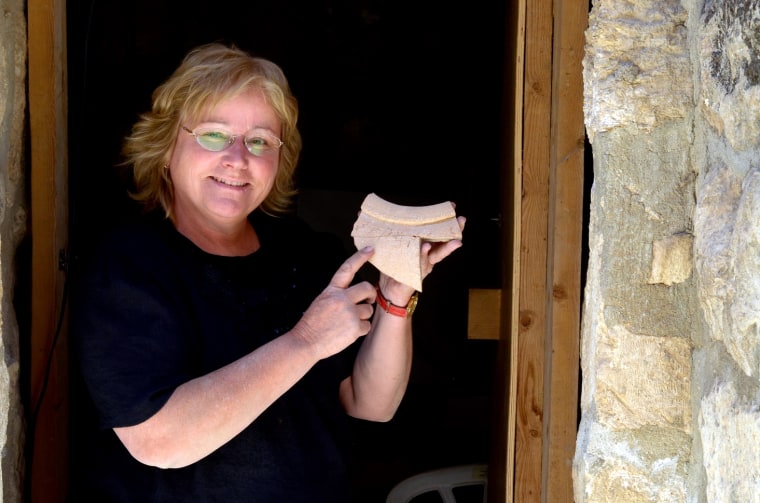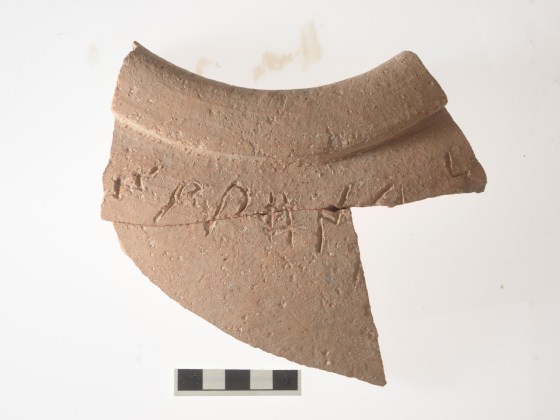Israeli archaeologists say a 3,000-year-old fragment of a ceramic jar found near Jerusalem's Temple Mount, dating back to the days of King David and King Solomon, bears a mysterious inscription that ranks as the earliest alphabetical written text ever found in the city.
The inscription is incised into the clay of a neckless ceramic jar found at Jerusalem's Ophel excavation site. The text is in the Canaanite language, which predates Israelite rule and the prevalence of Hebrew script. From left to right, the letters translate to M, Q, P, H, N, possibly L, and N.
The archaeologists behind the find, led by the Hebrew University of Jerusalem's Eilat Mazar, say that combination of letters doesn't correspond to any known word in west-Semitic languages — and thus, its meaning is unknown. But they suspect that the inscription specifies the contents of the jar or the name of its owner.
The discovery is detailed in a paper appearing in the Israel Exploration Journal, written by Mazar, Ben-Gurion University's Shmuel Ahituv and Hebrew University's David Ben-Shlomo. Ahituv studied the inscription, while Ben-Shlomo studied the composition of the jar.
The archaeologists said the fragment bearing the inscription was found along with pieces of six other large jars of the same type. All those fragments were used to stabilize the earth fill under the second floor of the building in which they were discovered, which dates to the 10th century B.C. — the era when Jerusalem was ruled by David and Solomon, two of the Bible's best-known figures.

The composition of the clay suggests that the makings for the jars originated in the central hill country near Jerusalem. Ahituv said the inscription is not complete: The full text probably wound around the jar's shoulder, and the fragment shows the end of the text, plus the first letter from the beginning. The archaeologists say it may have been written by one of Jerusalem's Jebusite residents. According to the Bible, the Jebusites were a Canaanite tribe who inhabited the city before David's conquest.
If the dating for the fragment is correct, the age of the inscription would rival other examples of proto-Canaanite inscriptions ever found — including a controversial text found on a fragment of pottery unearthed at the Hirbet Qeiyafa dig southwest of Jerusalem. Although that text was also written using Canaanite characters, archaeologists have suggested that it includes Hebrew words and thus represents the oldest known Hebrew inscription.
The inscription that Mazar and her colleagues describe is about 250 years older than the earliest Hebrew inscription found in Jerusalem. The Ophel excavation site lies in an area of Jerusalem known as the City of David, beyond the southern edge of the Temple Mount.
More about Israeli archaeology:
- Gallery: Eight Jewish archaeological discoveries
- Sphinx paws linked to Egyptian pharaoh dug up in Israel
- Israelis find 2,750-year-old temple
Alan Boyle is NBCNews.com's science editor. Connect with the Cosmic Log community by "liking" the NBC News Science Facebook page, following @b0yle on Twitter and adding +Alan Boyle to your Google+ circles. To keep up with NBCNews.com's stories about science and space, sign up for the Tech & Science newsletter, delivered to your email in-box every weekday. You can also check out "The Case for Pluto," my book about the controversial dwarf planet and the search for new worlds.
